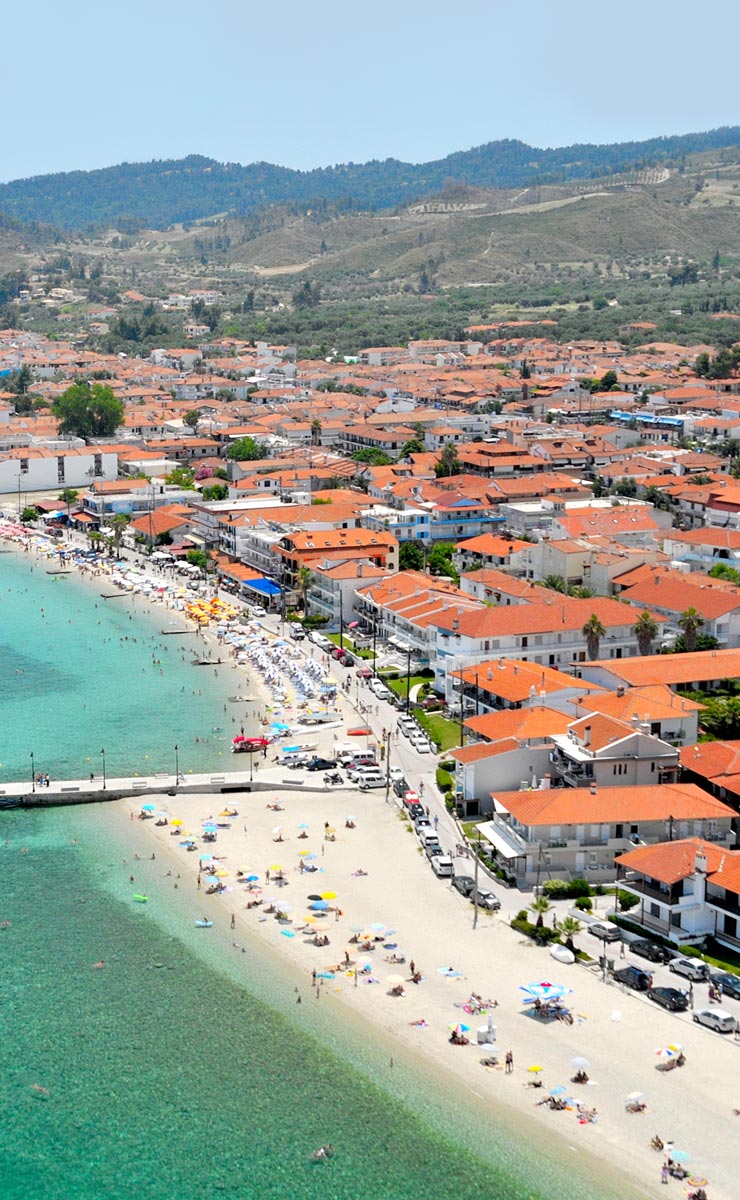Pefkohori (pop. 1,800) is a fairly sizeable village on the eastern shore of Kassandra, around 100km southeast of Thessaloniki, and about 15km from the cape at the furthest end of the peninsula. Pefkohori takes its name from the pines (pefka) which predominate the downward slope of the land towards Toroneaos Bay.
The further down (south) you go on Sithonia, the less crowded the beaches. Pefkohori is a great example of an uncrowded place that's worth the effort to get to. When going to Halkidiki, the best time not to arrive during the summer is Friday afternoon, when the road from Thessaloniki is jam-packed with weekenders from the city who have vacation homes on the peninsula.
Pefkohori's name used to be Kapsohora (Burnt Land), having been put to the torch a number of time by pirates. It was first settled in the late 1500's. It was one of the 12 named settlements of Sithonia during the Turkish Occupation. In the northeast part of the village, near the water, ruins of a Roman-era villa have been found. In the same area ancient coins have been found bearing the image of Lysimachus (361-281 BC), king of Thrace, Asia Minor, and Macedon. Lysimachus was one of Alexander's generals who inherited part of his kingdom, which was divided amongst his military rulers after his death.
The vibe in Pefkohori is very easygoing, and visitors have generally very positive impressions of the place. The beach, which has spread along the seashore as hotels to accommodate the growing tourist trade have gone up, is sandy, with the amenities of the village close at hand. The beach is well-organized, with sun beds, umbrellas, and water sports equipment on offer.
There are plenty of places to dine right on the water, with tavernas and cafes lining the brick-paved pedestrian walkway just back of the beach. Brick planters every 10 or 20 meters contain palm trees, and iron lamp posts dot the walkway, providing pleasant illumination for an evening stroll.
There is a stone-paved pier jutting into the water, with a 3 meter-high, graffiti-decorated, non-working little lighthouse. You can fish right off the pier, but you have to be crafty because the waters are so transparent that the fish can see you.
The village has brick-paved pedestrian thoroughfares, a nice fountain in its central square, and even an English-type pub. There are shops selling everything from pharmaceuticals to home-made sweets to inflatable beach balls. Planters with roses, bougainvilleas, and other flowers decorating the village.
There are some night clubs, bars and discos if you're in the mood to party at night. But by and large the environment in Pefkohori is low key.
Restaurants serve locally caught fish and locally vinted wines. When the wind blows towards the sea from the land during the late afternoon and the cooling hours after sunset, you can smell the aroma of the pines, which will help you remember where the village's name comes from.
A couple kilometers east, down the coastline from Pefkohori, is a rectangular natural inlet or marina about 800m long and 250 wide. Glarokavos Marina hosts sailing boat races. Fast speed Flying Dolphins ferries (passengers only, no cars) can take you from Pefkohori elsewhere in the northern Aegean or Halkidiki, while you can also hire smaller boats for day cruises.












